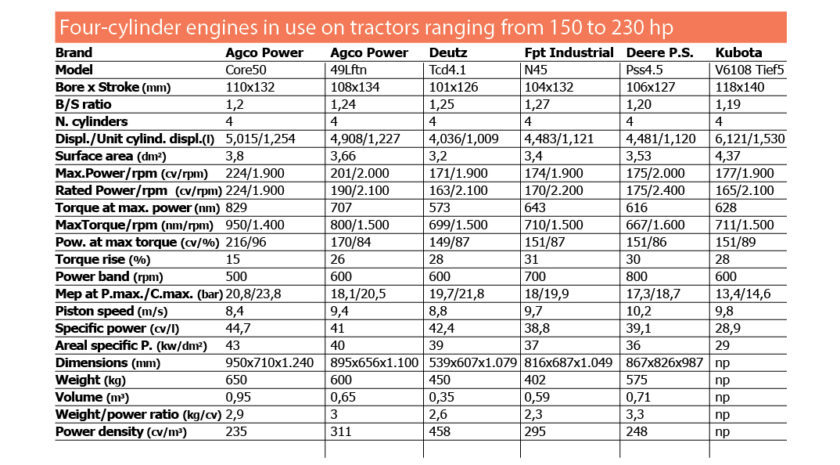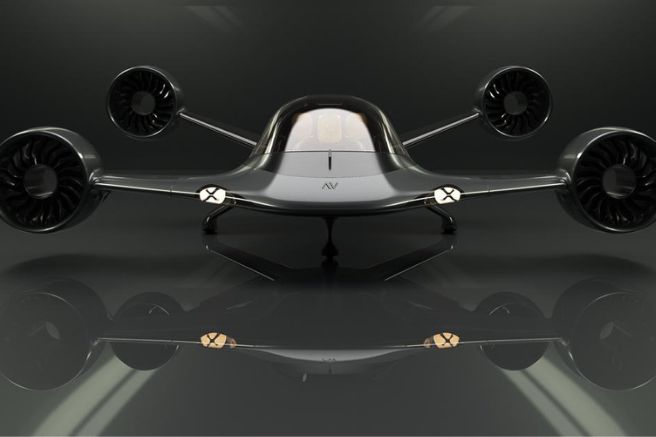The domestic market for medium to high-power tractors is witnessing a growing trend of machines with over 150 horsepower being increasingly equipped with four-cylinder engines instead of more segmented units. In these pages an overview of the most commonly used four-cylinder engines in agriculture and those available for Oem applications.
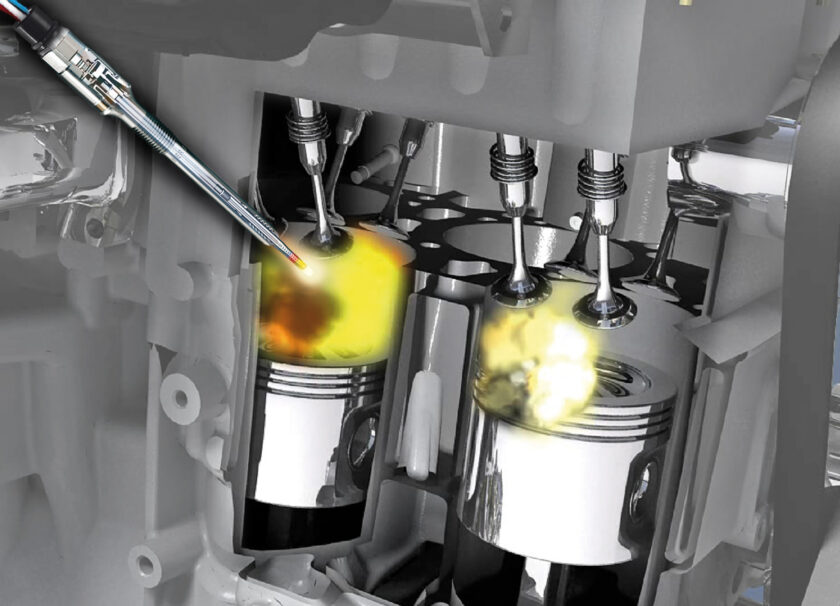
Go stronger, guys”. With this line, the spectacular and amusing, yet harmless, “brawl” concluded the 1972 movie featuring the unforgettable duo Bud Spencer and Terence Hill. This phrase aptly summarizes the market situation of high-power tractor engine solutions today, particularly those equipped with four-cylinder engines. This architecture is increasingly gaining performance and market favor, replacing more complex configurations.
Once, the 150 horsepower limit, acted as a virtual boundary between four and six-cylinder engines. However, technological advances in the sector have significantly raised this power threshold, making units more powerful and environmentally friendly. A recent innovation in the industry, the Agco Power “Core50,” is a state-of-the-art four-cylinder engine pushing its performance to around 224 horsepower. In the following pages, we’ll explore four-cylinder competitors to this newcomer, ranging from 150 to 230 horsepower. Approximately 34% of involved tractors are equipped with these four-cylinder units. All featuring turbo/intercooler systems, direct fuel injection, and displacements ranging from four to six liters.
Fpt Industrial N45
Starting with the most widely used in the power range among the four-cylinder high-power engines . The FPT Industrial’s “N45” four-cylinder, with a four-liter, 483-cubic centimeter displacement, positions itself between the more complex units of Agco Power and Kubota, and Deere Power Systems’ “Pss 4.5.” The “N45” powers models from Cnh Industrial. Such as New Holland’s “T6” and “T7” series, Case IH’s “Maxxum” and “Puma,” and Steyr’s “Impuls”. As well as Argo Tractor’s Landini “serie 7” and McCormick’s “X6” and “X7.” It is also present in Claas’s “Arion 470.”
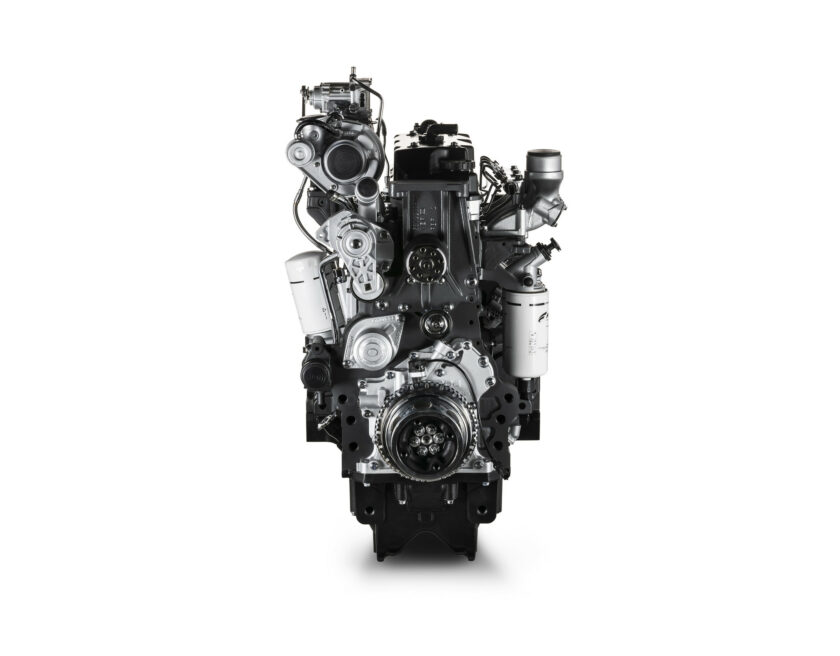
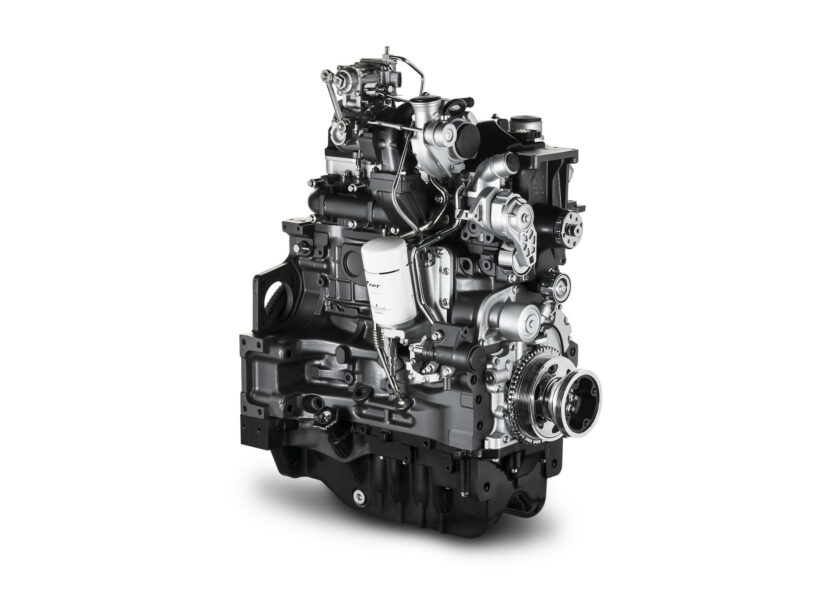
The turbo/aftercooler system enhances performance while maintaining a balanced combination of 176 horsepower at 1900 rpm and 710 Newton-meters of torque at 1500 rpm. These parameters result in a 31% torque rise and a power band of 700 rpm, while keeping mechanical stresses low. As indicated by the average piston speed under ten meters per second and the effective mean pressure stalling around 20 bar. The power density is also balanced, hovering around 40 horsepower per liter, with compact dimensions and a power density approaching 300 horsepower per cubic meter. Among the best in the analyzed units.
Agco Power 49Lftn
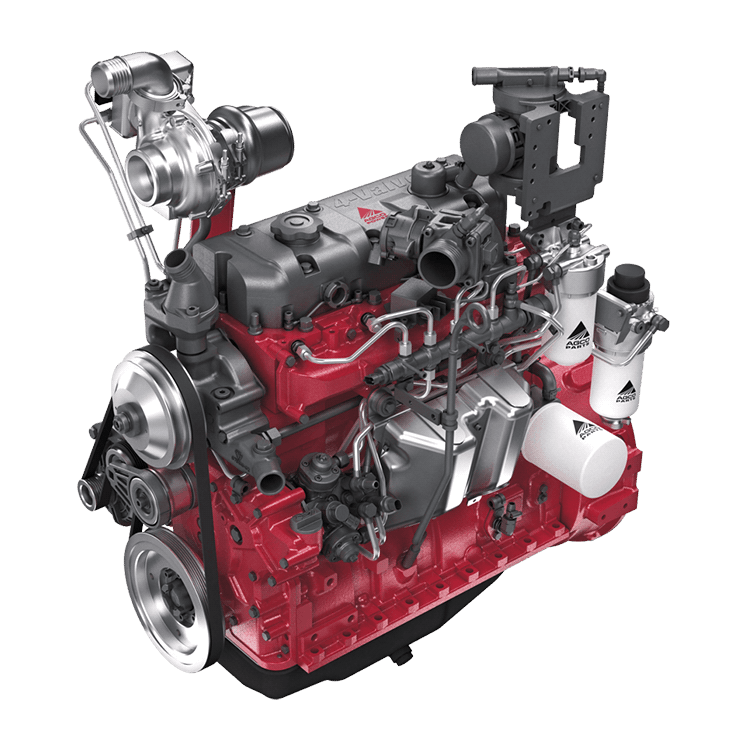
The Agco Power “49” series, concentrated in Massey Ferguson’s “6S” and “6700S” series and Valtra’s “N” series, fits into the more structured units of the group. With a displacement of four liters and 908 cubic centimeters, close to five liters, this engine reveals a ‘big block’ approach. Before the launch of the “Core50,” the “49” was the most performant four-cylinder. Delivering 201 horsepower at 2000 rpm and 800 Newton-meters of torque at 1500 rpm. The power density exceeding 40 kilowatts per square decimeter, achieved with an effective mean pressure of over 20 bar, signifies low stresses. Confirmed by a piston speed under nine and a half meters per second. Paying the price for its generous displacement, however, are the dimensions and weight, with the latter reaching nearly 600 kilograms. Resulting in a power-to-weight ratio of three kilograms per horsepower.
JD PowerTech Pss 4.5
This is second only to the three kilograms and three hundred grams of the Deere Power System “PowerTech Pss 4.5”. Offered by John Deere on some models of the “6M” and “6R” series, it is a four-cylinder engine with a displacement of four and a half liters. A unit volume of 120 cubic centimeters per cylinder. Based on geometries of 106 millimeters bore and 127 millimeters stroke. The maximum power is achieved at two thousand revolutions, with a torque of 667 Newton-meters reached at 1600 revolutions per minute. Average piston speed slightly exceeds ten meters per second.
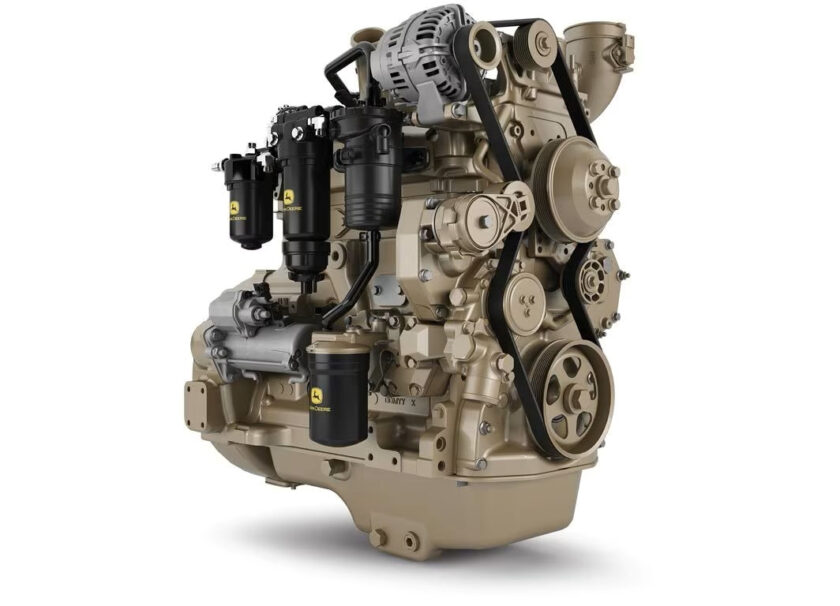
The maximum speed, at two thousand four hundred revolutions per minute, supports a broad usage range of 800 revolutions per minute. As well as high elasticity, confirmed by a 30% torque reserve. The specific power is just over 39 horsepower per liter, resulting in a power density of 36 kilowatts per square decimeter and a half. It is achieved with an effective mean pressure almost touching 19 bars. Primarily designed for agricultural use as a tractor engine, size and weight of the “PowerTech Pss 4.5” see, the first, contributes to a power density of 248 horsepower per cubic meter, while the 575 kilograms bring the power-to-weight ratio close to three and a half kilograms per horsepower.
Deutz Tcd 4.1
Compact yet capable of equipping the top models of the Fendt “500 Vario” series and Deutz-Fahr “6.4” series, allowing them to boast 170 horsepower, the Deutz engines “Tcd 4.1” are the most compact in the examined segment. With dimensions resulting in a power density of 485 horsepower per cubic meter and a weight of 450 kilograms. The German engine flaunts an enviable power-to-weight ratio of two kilograms and 600 grams per horsepower.
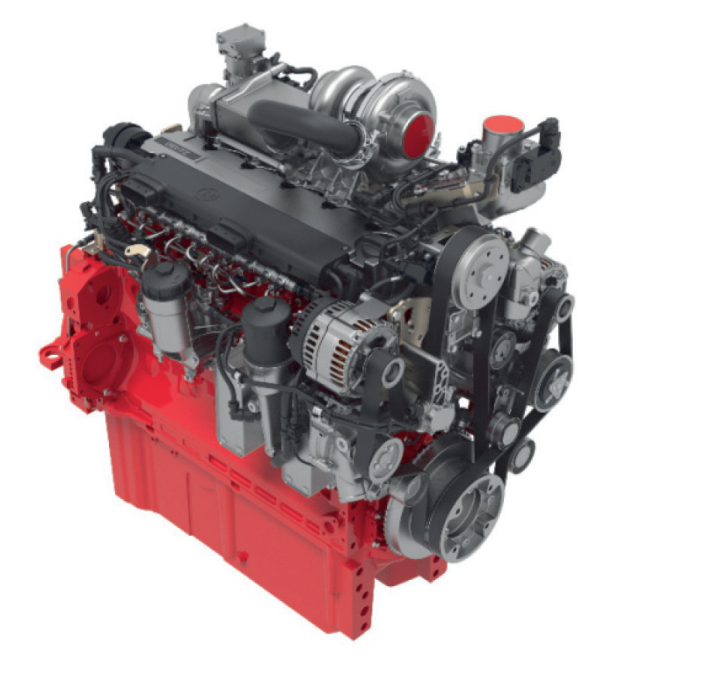
The nominal displacement of four liters is defined by a bore of 101 millimeters and a stroke of 126 millimeters. Resulting in a maximum power of 171 horsepower at 1900 rpm and a maximum torque of 700 Newton-meters available at 1500 rpm. The rated speed of two thousand one hundred revolutions per minute induces the lowest average piston speed in the segment, at under nine meters per second. At an effective mean pressure of nearly 22 bars, it achieves a power density of almost half a point higher than 39 kilowatts per square decimeter and a specific power touching 42 horsepower per liter.
Agco Power Core50
Currently used only on the four Fendt models of the “600 Vario” series, the new Agco Power “Core50”, derived from the six-cylinder “Core75” series, is undoubtedly intended to equip a large number of vehicles within the Agco galaxy in the future. Among its fundamental features, the first is an extremely flat torque curve. With the maximum torque of 950 Newton-meters available already at 1400 rpm and maintained steadily until 1600 rpm. Same flat and linear trend also for the rated power curve, which kicks in at one thousand seven hundred rpm and almost closes at the rated power speed of one thousand nine hundred rpm.
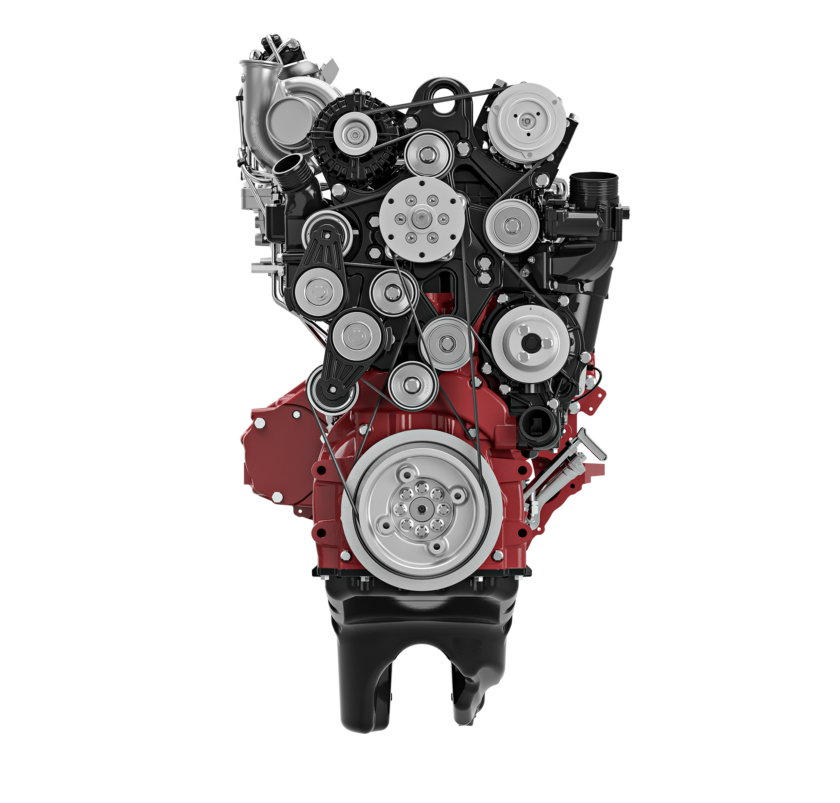
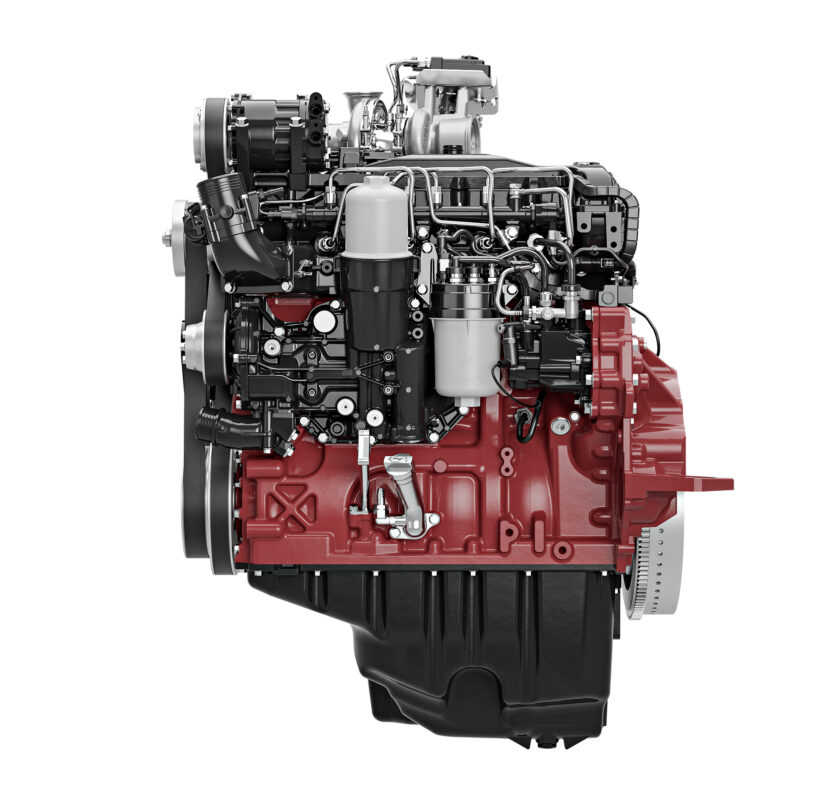
This results in apparent low elasticity on paper, with a 15 percent torque rise and a power band of 500 rpm. However, behind this lies the intention to design performance curves that optimize the continuous transmissions specified by Fendt, enabling operations with minimal fuel consumption. The unit is created with a bore of 110 millimeters and a stroke of 132 millimeters, defining a nominal five-liter displacement. While boasting a respectable volume, it would be wrong to consider it the sole factor for performance. Agco Power has done an excellent job in terms of fuel efficiency, extracting the maximum energy from thermodynamic processes.
Designed for agricultural applications
This is demonstrated by the highest effective mean effective pressure in the segment. Almost 24 bars at maximum torque, as well as a power density exceeding 43 kilowatts per square decimeter. And a specific power at the top of the segment with 45 horsepower per liter. However, it is inevitable that the same displacement will then impact dimensions and weights, although, as in the case of John Deere, these parameters have a relative impact in tractor applications. The power density is 276 horsepower per cubic meter, and the power-to-weight ratio is just below three kilograms per horsepower.
Kubota V6108
The last unit on the tractor market, particularly on the Kubota “M7003” series, is the four-cylinder “V6108 Tief5,” introduced to equip the current and more structured range of the brand. Engine that is not present in Kubota Engine’s motor offering, leaving the “V5009” with the top-of-the-range role. It should also be clarified that the designation “V6108” should not imply a different architecture from an inline one, nor are the current performances definitive.
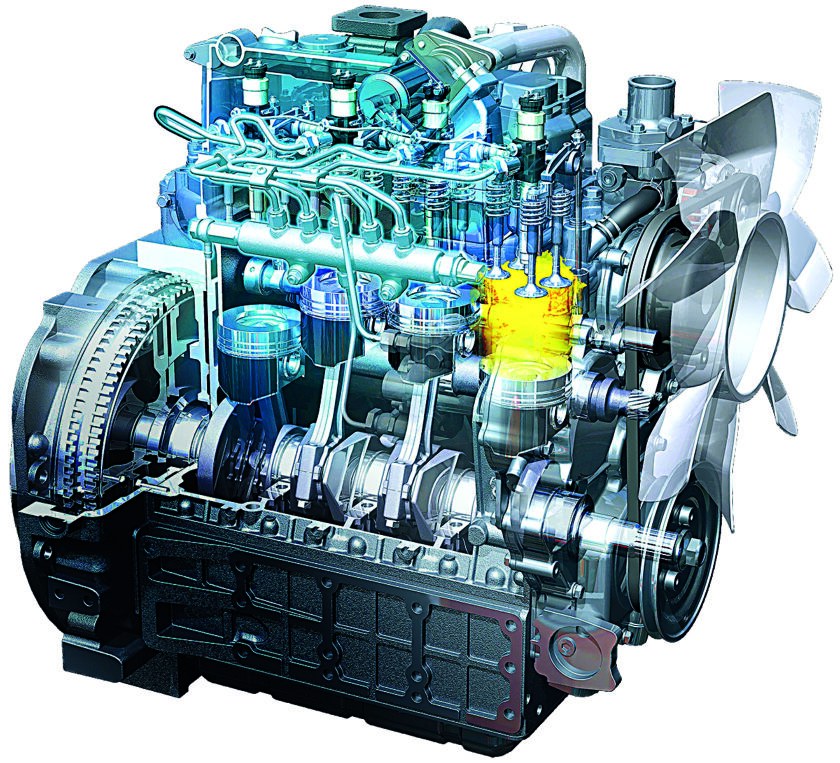
The 177 horsepower developed at 1900 rpm and the torque of 711 Newton-meters developed at 1500 rpm are actually lower than the true potential of an engine that proposes cylinders with a bore of 118 millimeters and a stroke of 140 millimeters. Defining a total displacement of six liters and 121 cubic centimeters. Currently operating based on an effective mean effective pressure that stalls at just over 14 and a half bars, and with a specific power touching 30 horsepower per liter, these performances confirm the potential currently untapped by an engine whose pistons work at an average speed just below ten meters per second. Resulting in a power density slightly below 30 kilowatts per square decimeter.”
Four-cylinder high-power engines
Author: Jacopo Oldani
Translated by ChatGPT

